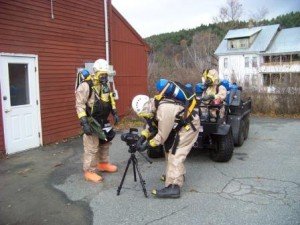Vermont and New York Teams Train Together
| DMNA Home page | More News Stories |
Civil Support Teams Hone Interoperability
Story by: Staff Sgt. Kevin Abbott, New York National Guard -
Dated: Wed, Oct 29, 2008
ST. JOHNSBURY, VERMONT -- National Guardsmen from New York, Vermont and Rhode Island, who are trained to detect chemical, biological, and radiological hazards, teamed up on a two-day exercise here to develop their skills and their ability to work together.
The members of New York’s 2nd Civil Support Team (CST) and Vermont’s 15th CST, as well as two members of Rhode Island’s 13th CST worked with the St. Johnsbury Fire Department on the Joint Collective Training Exercise.
The exercise was designed to improve interoperability so team members can plug in with any other team and still function.
"We need to understand and know how we each do business" said Lt. Col. Matthew Cooper, commander of the 2nd CST.
"It’s also important to build trust and confidence, to build a relationship with these guys", he said.
"This is a great opportunity for us to see how the New York Team works", added Lt. Col. Michael Young, the commander of 15th CST.
The CST teams and St. Johnsbury Fire Dept personnel observed each other run through CST lanes, then reversing roles of execution and observation.
"The objectives are to review Standard Operating Procedures and build a professional working relationship", said 2nd Lt. Lance Woodard., Medical Operations Officer of the 2nd CST.
Civil Support teams, whose full title are Weapons of Mass Destruction Civil Support teams ( WMD-CST ), were established to provide rapid support to local incident commanders when weapons of mass destruction are suspected.
They also provide expert technical advice on WMD response operations; and help identify and support the arrival of follow-on state and federal military response assets. They are joint force operation units manned by both Army and Air National Guard soldiers. They provide incident commanders with detection and identification of agents and substances and can then advise on response measures. They may also provide medical and technical advice.
"They (the 2nd CST) are a much senior team to us as they came on line several years before we did so they have been good mentors for our team", Young said said. "
“Any time we can work with another team is just excellent training." So much can be learned from just watching one another work through a scenario" Young added.
A scenario modeled by Captain John Stein, the operations officer of 15th CST, brought the Vermont team to St. Johnsbury from their home station near Burlington after an early morning alert.
The team made their way through the mountains of northern Vermont arriving on scene meeting with Incident Commander, Fire Chief Troy Ruggles, of the St. Johnsbury Fire Department. The 15th CST established a footprint and then proceeded to execute the training lane while being shadowed by New York’s 2nd CST.
The lane involved a survey team going down range to a nearby vacant building checking for unknown hazardous materials. The team moving carefully makes a very thorough examination of the building. Items of a suspicious nature are sampled for testing and the team moves back to the staging area where they first must go through a decontamination station and the samples are handed off.
Following the days training event an informal After Action Review was conducted back at the hotel. The scenario was laid out and each aspect of the operation examined and discussed by both the executing 15th CST and the 2nd CST observers.
"Its great to work with other teams", said First Lieutenant Ian Hepburn, the 15th CST Survey Team Leader. "Especially a team like New York. They mentored us when we were first stood up as a team." "This kind of training is good for all of us", he said.
Day two was essentially a role reversal with New York responding, establishing a footprint, setting up a decontamination station and all essential rear operations in the staging area. Once the decontamination station is certified and all essential rear operations are ready the survey team makes its way on a" gator" type all terrain vehicle to the building in question. This time the Vermont team shadowed New York observing their methods.
“ These guys are dedicated professionals. You have to want to be here, these guys want to be here. They want to get it right. It takes a certain type of individual to fit and to be part of this team,” Cooper, the 2nd CST Commander, said.
URL: https://dmna.ny.gov/news/?id=1225486154
216.73.216.158
Page Last Modified: Fri, Jan 16, 2009




